October proves deadly for US in Iraq
Capping the bloodiest month for American troops since January, the US military reported that seven more American soldiers have been killed.

Military commanders have warned that armed fighters will step up their attacks in the run-up to the 15 December election, when Iraqis will choose their first full-term parliament since the collapse of Saddam Hussein’s government in 2003.
To guard against such attacks, the military has raised the number of American soldiers in Iraq to 157,000 – among the highest levels of the Iraq conflict.
Most of the combat deaths and injuries in recent months have been a result of the increasing use by armed fighters of sophisticated homemade bombs, responsible for the deaths of the seven Americans killed since Sunday.
The military refers to those bombs as “improvised explosive devices,” or IEDs.
Highest-ranking soldier
Last Friday, an IED killed Colonel William Wood, 44, of Panama City, Florida, an infantry battalion commander.
He was promoted posthumously, making him the highest-ranking soldier killed in action in the Iraq conflict, according to the Pentagon.
 |
|
Pentagon’s Lawrence Di Rita (L): |
“We see an adversary that continues to develop some sophistication on very deadly and increasingly precise stand-off type weapons – IEDs, in particular,” Pentagon spokesman Lawrence Di Rita said on Monday.
The fighters continually search for new and more effective ways to use IEDs, di Rita said, while US forces look for new ways to counter the threat.
“We’re getting more intelligence that’s allowing us to stop more of these things, find more of them. So we’re learning from them and the enemy is learning from us, and it’s going to be that way for as long as there is an insurgency,” Di Rita said.
‘Triangle of death’
Monday’s deadliest attack against US soldiers came in an area known as the Triangle of Death.
Four soldiers from the US army’s Task Force Baghdad died when their patrol struck a roadside bomb in Yusifiya, 19km south of Baghdad.
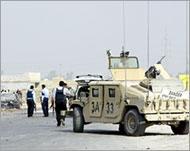 |
|
US army convoys are often |
Two other soldiers from the army’s 29th Brigade Combat Team were also killed in a bombing on Monday near Balad, north of the capital.
The US military also reported that a marine died the day before in a roadside bombing near Amiriyah, a focus for fighting 40km west of Baghdad.
The US military death toll for October is now at least 92, the highest monthly total since January, when 106 American service members died – more than 30 of them in a helicopter crash that was ruled an accident.
Only during two other months since the war began has the US military seen a higher toll: in November 2004, when 137 Americans died, and in April 2004, when 135 died.
The latest deaths brought to 2025 the number of US service members who have died since the US invaded Iraq in March 2003. The number includes five military civilians.
Iraqi death toll
The ongoing violence has killed a far greater number of Iraqis.
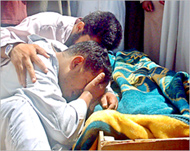 |
|
Since US-led invasion in 2003, up |
Earlier on Monday near the Syrian border, marines backed by jets attacked targets in a cluster of towns and villages near the Syrian border.
The raid was part of an ongoing operation in an area believed heavily infiltrated by al-Qaida in Iraq and foreign fighters.
A marine statement said US aircraft fired precision weapons, destroying two safe houses believed used by al-Qaida figures.
The statement made no mention of casualties, but Associated Press Television News video from the scene showed residents wailing over the bodies of about six people, including at least three children.
At the local hospital, Dr Ahmed al-Ani said 40 Iraqis, including 12 children, were killed in the attack.
Children killed
The footage from the scene showed Iraqi men digging through the rubble of several destroyed concrete buildings with a pitchfork or their hands.
In the building of a nearby home, women wept over about half a dozen blanket-covered bodies lined up on a floor. Some of the blankets were opened for the camera showing a man and three children.
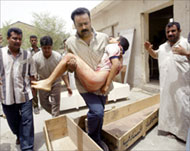 |
|
Children are often victims of |
“At least 20 innocent people were killed by the US warplanes. Why are the Americans killing families? Where are the insurgents?” one middle-aged man told APTN.
“We don’t see democracy. We just see destruction.” He didn’t give his name.
According to the UK-based Iraq Body Count, the number of civilians killed since the US-led invasion of Iraq has risen to a maximum of 30,163.
The project, run by academics, researchers and peace activists, was established as an independent and comprehensive public database of media-reported civilian deaths in Iraq.
Iraqi troops targeted
Iraqi security forces, taking on an increasingly active role in operations, are now the main target of armed fighters in northern and western Iraq.
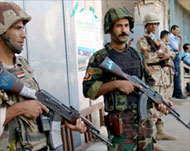 |
|
Iraqi armed forces should number |
“Over the past three months, of the 180 attacks against armed forces in Salah al-Din province, more than two-thirds were aimed at Iraqi patrols,” said police Colonel Mohammed Khalis al-Samarai.
The story is the same in the neighbouring western province of al-Anbar.
Lieutenant-Colonel Jawdat Khudair al-Dulaimi, from Jazira near town of Falluja, accuses the armed fighters of mainly targeting Iraqi forces.
“How can people who call themselves Muslims spill the blood of other Muslims, while ignoring their enemy?” he asked, referring to the American forces.
He also complained that Iraqi police were less well equipped than both the US forces and the fighters.
Weakest link
Analysts believe armed fighters mainly target Iraqi forces because they remain the weakest link in the security network.
This allows them to increase their chances of success while limiting their own losses.
|
“Why are the Americans killing families? Where are the insurgents? We don’t see democracy. We just see destruction” Unnamed Iraqi quoted by APTN |
Nationwide, over the first nine months of the year, 970 Iraqi policemen and 388 Iraqi soldiers have been killed, according to the government.
The higher profile given to Iraqi forces in recent US-planned operations against the fighters’ strongholds in Falluja, Samarra and Tal Afar in the north and west of the country has also raised the level of local hostility.
This is sometimes compounded by the fact many of those now joining the new Iraqi forces are from the dominant Shia community, while the population in much of central and western Iraq is Sunni.
US forces have been building up Iraqi security forces and US President George Bush has said US-led forces will step down as the Iraqi forces step up.
The new Iraqi security forces, many of them built from scratch following the overthrowing of the Saddam government, now number nearly 192,000 men.
These comprise 87,000 members of the armed forces, 69,000 policemen and nearly 36,000 other interior ministry forces.
Special battalions
According to US officials, there are now 88 Iraqi army and special operations battalions involved in combat operations, 36 of which are considered capable of operating on their own.
There are also 28 special police battalions, two of which are assessed as ready to take a lead role in operations against armed fighters.
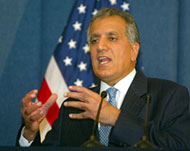 |
|
Zalmay Khalilzad: US military |
Iraqi armed forces should reach their full complement of 131,000 men by the end of 2006.
The US ambassador to Iraq, Zalmay Khalilzad, has said that political progress and improving home-grown security forces might allow the United States to cut its military presence next year.
“I do believe it’s possible that we could adjust our forces, downsizing them in the course of next year,” Khalilzad during a visit to White House.
Calls for Bush to set a firm timetable for withdrawing the more than 140,000 US soldiers in Iraq have multiplied, as public opinion polls suggest the war is proving increasingly unpopular in the United States.